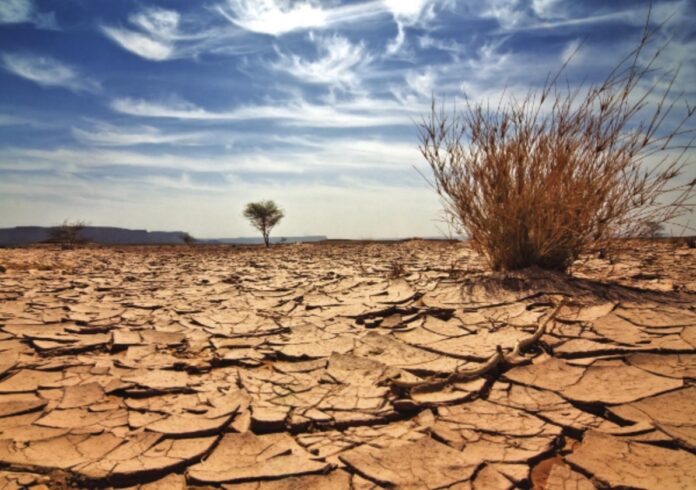By Keith Hayward
Highlighting drought as an “existential threat to many parts of the world”, the UN Office for Disaster Risk Reduction, in its ‘GAR Special Report on Drought 2021’, seeks to raise awareness of the risk posed by the periodic lack of water. “The risks that drought poses to communities, ecosystems and economies are much larger and more profound than can be measured,” it states.
The aim of the report is to help move forward thinking and action, offering “a clear step forward” in building awareness of the characteristics of drought. The main thrust of the report is to call for a systemic approach and for adaptive governance. “It builds the case for a new approach to drought risk management,” it states.
The report illustrates the systemic nature of drought risks with examples such as the role of physical feedback loops where, for example, droughts in Europe in spring are connected to a higher probability of heatwaves in summer. In the wider agroclimatic system, a heatwave during an important crop growth stage can lead to crop failure and nutrient losses, with further rapid and irreversible changes potentially occurring as a result.
Drought is a concern because of its broad impacts, with most of these being indirect ones. “They cascade through economies and communities and continue over time, dwarfing direct losses,” the report notes. So, the systemic aspects also include cascading impacts such as loss of crops and spikes in prices and resulting social vulnerabilities, with individuals, communities and even nations potentially seeing their economic strength reduced.
Climate change is further complicating the picture. An effective response to the threat posed by drought requires management and governance that is designed to adapt over time. The report sets out what are described as “a basic set of key actions” both to develop the evidence base that is needed and to inform and support improvements at all levels – from international agencies right down to the community level.
Key actions
One important area of action is to invest in drought risk identification and mapping. Here, the report identifies a need to map decision making arrangements and stakeholders. Given the importance of action at the local level, this should include the public and private sectors, civil society and the science and technology community – as a step towards them taking part in drought risk management, design, planning and implementation.
Resilience-based approaches need to be mainstreamed, so another important area is for shared visions to be co-developed, with systematic coordination across actors, sectors and levels of governance going beyond ad hoc projects.
Actions on mechanisms for offering social protection should include conducting impact-based drought risk assessments focused on vulnerable communities in national and sector development planning and investment. There is also a need to ensure social accountability, for which action can include placing policy responsibility for drought risk reduction in a single unit with political and investment authority.
Finally, there is a need to promote coherence across implementation of the various international initiatives, such as the 2030 Sustainable Development Goal agenda and the Paris Agreement, in connection with drought risk reduction. This should include piloting and implementing innovative financial strategies to upgrade settlements, and promoting benefits of technology and efficiency of water, energy and land use.
The path to change
These are the key actions needed. The bigger challenge is of how to see these actions progressed and implemented.
The report summarises the systemic nature of drought risk as follows: “Increasingly globally networked risks, local imbalances, the resulting contagion of cascading risks and ensuing actions are overwhelming traditional approaches to drought risk management. Systemic innovation strategies for equitably addressing such multi-scaled risks are fundamentally different from regular innovation strategies, in that they are founded on notions of complexity, ambiguity and diversity to manage present risks and adapt and thrive as new risks emerge.”
This points to the need for a change of approach if the key actions are indeed to see progress. The report continues: “Instead of targeting only one outcome (e.g., a high crop yield), systems-based management aims at the capacity of systems and people to be able to imagine, adapt and co-produce a sustainable and equitable future.”
The report notes that decisions are often not based solely on weighing up costs and benefits but on experience, culture and values. The authors see this as the key to action.
“An immediate and critical need is to craft new narratives of measures of human well-being and interaction with natural systems, within and among countries in increasingly drought-prone, drought-emergent and water-scarce seasons and regions,” the report states.
Drought action as a driver for sustainability
In fact, the authors see that lessons from how the world approaches drought can be put to use in other areas. “Droughts provide a useful analogue and practical experience for a much wider suite of complex and growing risks – including those posed by climate change,” the report notes. The value comes from the combination of the uncertain nature of projected impacts and the need for a flexible approach.
The authors see that embracing a systemic approach can support a wider shift to sustainability.
“A significant challenge in the development of pathways for living sustainably with nature and with increasingly complex drought-related risks will be in guiding evolution of financial and economic systems towards a globally sustainable economy,” the report states, continuing: “This will involve steering away from the current limited paradigm of economic growth and drawing upon diverse value bases and sources, including indigenous and local knowledge.”
This presents a crucial role for the new narratives: “Such narratives would show the limits of current systems and business-as-usual actions in reducing risks into the future, and articulate shared values and opportunities for realizing the benefits and dividends of adaptive governance of systemic risks for global, national and local communities.”









